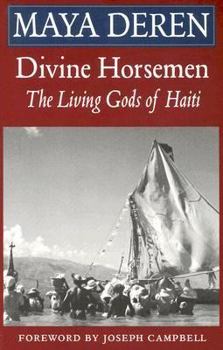Divine Horsemen: The Living Gods of Haiti (Revised)
Select Format
Select Condition 
Book Overview
This is the classic, intimate study, movingly written with the special insight of direct encounter, which was first published in 1953 by the fledgling Thames & Hudson firm in a series edited by Joseph Campbell. Maya Deren's Divine Horsemen is recognized throughout the world as a primary source book on the culture and spirituality of Haitian Voudoun. The work includes all the original photographs and illustrations, glossary, appendices and index. It...
Format:Paperback
Language:English
ISBN:0914232630
ISBN13:9780914232636
Release Date:October 1983
Publisher:McPherson
Length:350 Pages
Weight:1.10 lbs.
Dimensions:1.1" x 5.8" x 8.4"
Customer Reviews
5 ratings
magic and cinema
Published by Thriftbooks.com User , 22 years ago
The other reviewers do a good job of discussing Deren's history of Haitian Voodoun, however, it should be noted that regardless of the merits of this as an historical text, the book is a fascinating read for anyone interested in her film practice. Perhaps this is obvious, but it is unmentioned by some others.
Explores the theology & philosopy of Haitian Voodoun
Published by Thriftbooks.com User , 24 years ago
Maya Deren's "Divine Horsemen" is a poetically rendered exploration of the philosophy and practices of Haitian Voodoun. Written in the early '50's (with the support of Joseph Campbell), this book is not a "how to" practical guide. Rather it a metaphysical, religious, philosophical & anthropological study of Voodoun. As an artist, Deren brings a uniquely lyrical voice to her narrative and paints a multi-textured, infinitely complex portrait of a spiritual tradition with roots stretching back to the very dawn of humanity. In reading this book I was awed by an awareness of the sophisication and perception of the so-called "primitive" people of West Africa (from which Voodoun derives). They were only "primitive" in terms of the development of technology, certainly not in the development of the spirit. Reading this has created a profound shift in my view of the history of civilization as taught to me in school. This book is essential reading not only for anyone interested in Voodoun, but also for any student of comparative religion, mythology or spirituality.
A Bridge Between Art and Ethnography
Published by Thriftbooks.com User , 25 years ago
This is an excellent history of the African origins of Voudoun ( creole 'spelling' used by Deren) and its transplantation to the New World. When the subject of spirit possession comes up, Deren questions why the most impressive phenomenon of Voudoun is not seen as a direct pragmatic expression of the principles of the religion . There is a chapter on this called 'The White Darkness' which Deren cautions should not be seen as a 'personal' experience but service to the 'loa' or Voudoun deity. Nevertheless this has been misinterpreted as Deren's 'deed', which has laid ground for several unfounded myths about the filmmaker. Her participatorial observations ran against the grain of traditional orthodox male anthropologists of the time and she realized that she would be attacked for encroaching on their turf. That is why DH should be seen as an important feminist ethnography. Deren described the relationship between magic, science and religion which was at the apex of modernism. This research interrupted her film career as she was hard at work with this before she made her first film in 1943. She later returned to this as recipient of a Guggenheim fellowship for creative work in motion pictures in 1947 . Over 20,000 feet of film were shot by Deren in Haiti and remained unedited as she later came to see that it was impossible to alter the forms of the rituals of Voudoun. For that reason it is claimed that she never made a film and that her involvement in Voudoun destroyed her work as an artist which are fallacies. This book is a must to understand the complexity of this outstanding artist and ethnographer
Deren offers artist's perspective on vodou.
Published by Thriftbooks.com User , 25 years ago
I agree with all but one of the statements made by carnero@juno.com: Deren was not an academic at all. Rather, she went to Haiti as a filmmaker, intending to study and film ritual dance. In her preface, she discusses at length her unique vantage point as an artist rather than an anthropologist. This is part of why her book is so wonderful: it is clearly infused with an artist's--and ultimately an adherent's sensibility.
Great!! Terrific!!!
Published by Thriftbooks.com User , 26 years ago
This is one of the greatest books on Afro-Caribbean religion. Its one problem is that it is really written by academic researchers for other academics. But! It will help the serious scholar and devoted non scholar understand the essence of Vodun and other Afro-Caribbean religions.




